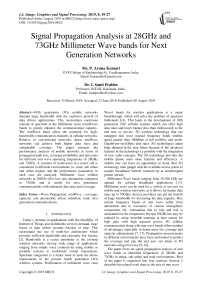Signal propagation analysis at 28GHz and 73GHz millimeter wave bands for next generation networks
Автор: P. Aruna Kumari, I. Santi Prabha
Журнал: International Journal of Image, Graphics and Signal Processing @ijigsp
Статья в выпуске: 8 vol.11, 2019 года.
Бесплатный доступ
Fifth generation (5G) mobile networks demand large bandwidth with the explosive growth of data driven applications. This necessitates enormous amount of spectrum in the Millimeter wave (mmWave) bands to greatly enhance the communication capacity. The mmWave band offers the potential for high-bandwidth communication channels in cellular networks. Relative to conventional networks, dense mmWave networks can achieve both higher data rates and comparable coverage. The paper presents the performance analysis of mobile networks in terms of propagation path loss, coverage probability and data rates for different mm wave operating frequencies of 28GHz and 73GHz. A scenario of multi-users in a micro cell is considered in different environments i.e. rural, sub urban and urban regions and the performance parameters in each case are analyzed. Millimeter wave cellular networks at 28GHz offer less rain attenuation compared to 73GHz and is useful for next generation communications with enhanced data rates and coverage.
Wave Propagation, mmWave, coverage, capacity, rain attenuation, urban, suburban, rural, next generation communications
Короткий адрес: https://sciup.org/15016072
IDR: 15016072 | DOI: 10.5815/ijigsp.2019.08.02
Текст научной статьи Signal propagation analysis at 28GHz and 73GHz millimeter wave bands for next generation networks
I. Introducton
Today’s increase in applications with the feasibility of Internet of Things and multimedia services demand, large bursts of data within seconds fraction of time. This necessitates the use of multi-tier architecture which provides sufficient bandwidth and extremely low latency [2]. Bandwidth is a scarce parameter in the existing wireless networks serving wide range of applications ranging from simple voice connectivity using mobile or portable systems to worldwide virtual transactions. Spectrum congestion is a major issue to meet the above requirements in the present fourth generation (4G) wireless systems. Proliferation of millimeter wave (mm
Wave) bands for wireless applications is a major breakthrough, which will solve the problem of spectrum bottleneck [14]. This leads to the development of fifth generation (5G) cellular systems which can offer high data rates and lower latency(less than millisecond) to the end user or service. 5G wireless technology that use untapped mm wave unused frequency bands enables speed greater than 100Mbps at full mobility and multi-Gigabit-per-sec(Gbps) data rates. 5G technologies attain huge demand in the near future because of the advanced features in the technology i.e possible with the integration of new radio concepts. The 5G technology provides the mobile phone users more features and efficiency. A mobile user can have an opportunity to hook their 5G technology mini gadget with the available access points to acquire broadband internet connectivity at uninterrupted greater speeds.
Millimeter Wave bands ranging from 30-300 GHz are opened for cellular broadband applications [17]. Millimeter wave can be used for a variety of services on mobile and wireless networks, as it allows for higher data rates up to 10Gbps. Service providers can get the benefit of huge bandwidth for increasing the data capacity. But, certain frequency bands of mm wave suffer from attenuation due to resonance of various atmospheric components [6]. Attenuation due to rain and hail is substantial for the frequencies beyond 10GHz but may be reduced by using steerable antennas at base station for high gain with high transmit power. 5G cellular communication along with mm wave bands offers number of advantages especially in dense areas for coverage and capacity enhancement [7, 17]. Propagation measurements in different environments have been performed to predict the coverage and rate the end user can attain in 5G networks using mm wave [9, 16].
The paper focus on signal propagation analysis of mm wave bands at identified frequencies of 28GHz and 73GHz in urban, sub urban and rural environments. Rest of the paper is organized into four sections. Section 2 describes the related work done in the area of mm wave frequency bands for cellular networks and 5G system concepts. Section 3 presents the proposed simulation model for the three propagation environments. Results and discussions are presented in section 4 which includes performance comparison of propagation models at 28GHz and 73GHz mmWave frequencies and finally conclusions are presented in section 5.
II. Background
The large bandwidth in the mm-Wave bands promotes the usage of mm-Wave communications in the 5G cellular access. With huge bandwidth, the system is able to achieve peak data rates in excess of 10 Gbps and edge data rates of more than 100 Mbps [8]. Federal Communication Commission has released spectral bandwidth of 10.85 GHz for frequencies above 24GHz [3]. This solves the problem of spectral congestion and provide a promising solution for worldwide broadband wireless applications. METIS project is working towards the development of 5G technology by complementing new radio concepts on existing systems to meet the new challenges that the existing networks could not support. 5G technology integrate the concepts of Massive MIMO, Ultra dense networks, small cells, Antenna diversity, machine – machine communications. Xianghao Yu et al. (2014) stated that MmWave cellular networks have the potential for high coverage and capacity as long as the infrastructure is densely deployed. On the basis of extensive propagation measurement campaigns at mm-Wave frequencies, the feasibility and efficiency of applying mmWave communications in the cellular access have been demonstrated at 28 and 73 GHz [11, 13]. S. Akoum et al. (2012) has done the primary work on coverage and capacity analysis have not considered the actual mm wave scenario path loss models. At higher mmWave frequencies, path loss increases drastically for the antennas using constant gain over a particular frequency. This may be decreased by keeping the effective aperture of the antenna constant over frequency at both the ends [4]. MmWave frequencies with smaller wavelengths exhibit different propagation characteristics whether the Transmitter and Receiver are in Line of Sight (LOS) or in Non Line of Sight (NLOS). Hence the condition of LOS or NLOS constraint need to be considered in determining the performance analysis of mmWaves. NLOS condition exhibit greater signal attenuation compared to LOS with respect to user distance from the base station [18]. T. S. Rappaport et al. (2015) presented calculation of mean path loss arises due to both LOS and NLOS regions gives considerable results in any scenario. This requires the probabilistic path loss determination of LOS and NLOS. The research work done so far on 5G path loss models using mmWaves is performed considering a specific environment. The present work illustrates the microcell scenario in all the three propagation environments in LOS and NLOS conditions at identified frequencies of 28GHz and 73GHz.
Electromagnetic waves exhibit attenuation due to rain, through the process absorption and heterogeneous scattering. Rainfall attenuation is a phenomenon relative to the rainfall rate and frequency which results in increasing path loss, limiting the coverage area, and consequently degrading the system performance. Based on the approximate relation between specific attenuation (Л) and rain rate , an empirical form is used to find the impact of rain on radio wave propagation given by X(db/km) = aR b Where, R is the rain rate in mm/hr and parameters a and b are functions of frequency and polarization [8]. S. Sun et al. (2016) observed substantial attenuation of 10dB/Km at 73 GHz is caused by rain and hail compared to 0.1dB/km at 28 GHz. However this attenuation may be overcome by employing additional antenna gain or transmitter power. This requires adaptive beam steering at both base station and user equipment, using adaptive antenna arrays. Afif Osseiran et al. (2014) stated that the integrated technology with the identified mmwave bands increases the spectral capability for wide range of applications which demand GHz bandwidths at greater speeds
-
III. Proposed Model
A micro-cell with n users and a base station is considered in Figure 1. Radius of the cell (R) is set accordingly for the specific propagation environment as given in Table 1. Each user experience different received power and Signal to Interference Noise Ratio (SINR) based on the distance the user is present and on dynamic network conditions like traffic load, transmitted power and interference. The performance parameters include path loss, received power, SINR, capacity and coverage probability. Proposed model consists of a single microcell and a base station(BS) transmitting power ‘Pt’ and n-users (UE 1 ,UE 2 ,…., UE n ) receiving powers of P R1 ,P R2 ,…P Rn . Assuming ‘L mm ’ to be the path loss in the mmWave channel between BS and UE.
-
A. Performance Parameters / Metrics:
Path loss: is the reduction in power density (attenuation) of an electromagnetic wave as it propagates through space between transmitting and receiving stations. In mobile communication, transmitter is base station and user equipment is receiving station. Mathematical forms for path loss calculations for mmWave communications are considered from the references [15, 18].
Based on the location of the UE, whether it is in sight of the base station or out of sight, different path loss exponents are considered for Line of Sight (LOS) and Non Line of Sight (NLOS) regions.
Power received by a user at distance ‘d > d o ’ from the base station with transmitting power ‘P t ’ is given by the equation (1)
P d,mm
= P t
—
L mm
L mm is the pathloss in dB in mm-wave channel i.e given by equation (2)
L_ ( d ) = L p ( d o ) + 10 n log 1+ / .
L p (d o ) is free space path loss at Close-In reference distance ‘d o ’ is of the form .
Where P d,mm is the received power of UE at distance ‘d’ P d(x) is the received power at distance ‘x’ other than ‘d’
CT 2 is the noise power with Bandwidth B.
ct 2 = KTBR
Capacity: The rate at which the user can receive the data with channel bandwidth ‘B’ having ‘N’ no. of users is given by equation (5)
L p ( do ) = 20log10f ^'d 1
V Л )
Capacity = B log2 ( 1 + SINR ) (5)
‘n’ is path loss exponent and takes different values for LOS and NLOS regions.
‘ᵡ σ ’ is shadow fading factor assuming Zero-mean Gaussian noise and variable for LOS and NLOS conditions.
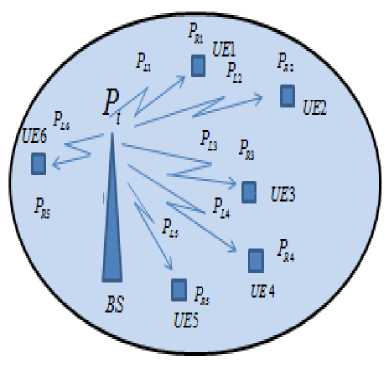
Fig.1. n users considered in a single micro cell with base station BS.
SINR : SINR is an important metric in determining the coverage and capacity. Assuming that user is at origin and base station is at distance ‘d’ then Signal to Interference Noise Ratio experienced by the user is given by equation (4)
Coverage Probability: The probability that a given user can achieve some target threshold SINR (τs) measures the coverage probability, given by equation (5).
P c ( T s ) = P ( SINR > T s )
P ( SINR > Ts ) = Q f( SINR T s ^1 (6)
Improved SINR results in increased capacity and better coverage probability.
-
IV. Results And Discussion
The proposed work is implemented in MATLAB considering 50 users randomly deployed in a square grid with base station at the center. The performance parameters for this model are calculated at two different operating frequencies of 28GHz and 73GHz in urban, sub-urban and rural microcell scenarios. Figure 2 depicts 50 users randomly deployed in a square grid with base station located at the center (25, 25) of the square grid.
Table1 and Table2 depicts the simulation parameters considered for the performance evaluation of mm Wave networks under different environments at two carrier frequencies (f c ) 28GHz and 73GHz with transmitted power-30dBm.
SINR =
P d,mm
У a Pd ( x ) + CT г
^^ x ^ ф, x * d d
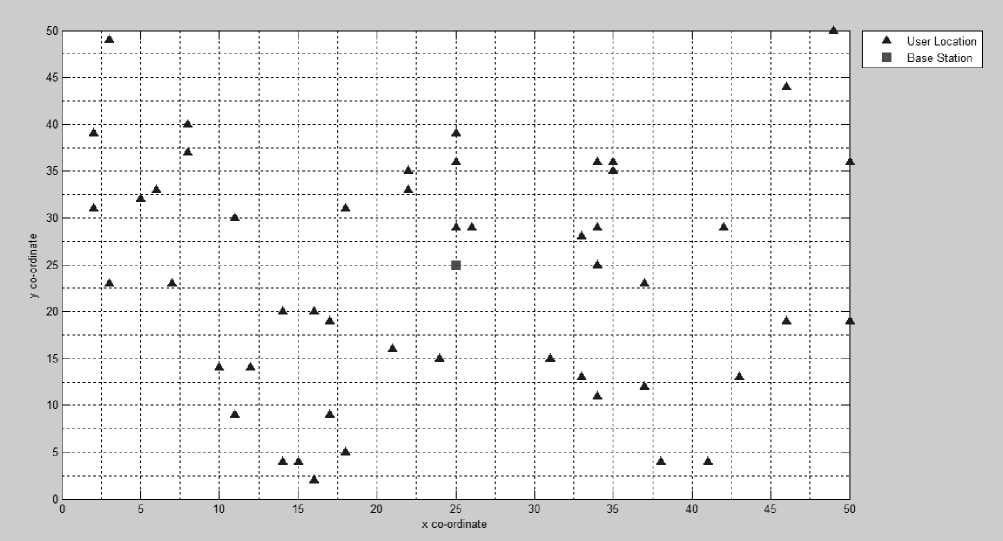
Fig.2. Proposed model of 50 users deployed in a square grid
Table 1. Simulation Parameters (3GPP, TR 38.901) at 28GHz mmWave band
|
Parameters |
Urban |
Deployment area Sub-Urban |
Rural |
|
LOS Path Loss Exponent(n LOS ) |
2 |
1.5 |
1 |
|
NLOS Path Loss Exponent(nNLOS) |
3.4 |
2.1 |
1.8 |
|
Close-In Reference distance(d o ) |
1m |
1m |
1m |
|
LOS Shadowing factor (σ LOS ) |
3.6dB |
3.4dB |
3.6dB |
|
NLOS shadow fading factor (σ NLOS ) |
9.7dB |
9.4dB |
8.3dB |
|
Noise power (σ2) |
80.817dB |
80.817dB |
80.817dB |
|
Rate of rainfall(R) |
42mm/hr |
42mm/hr |
42mm/hr |
Table 2. Simulation Parameters (3GPP, TR 38.901) at 73GHz mmWave band
|
Parameters |
Urban |
Deployment area SubUrban |
Rural |
|
LOS Path Loss Exponent(n LOS ) |
2.1 |
1.7 |
1.2 |
|
NLOS Path Loss Exponent(n NLOS ) |
3.4 |
2.3 |
2.1 |
|
Close-In Reference distance(do) |
1m |
1m |
1m |
|
LOS Shadowing factor (σ LOS ) |
5.2dB |
4.8dB |
4.8dB |
|
NLOS shadow fading factor (σ NLOS ) |
7.9dB |
7.2dB |
6.8dB |
|
Noise power (σ2) |
80.817dB |
80.817dB |
80.817dB |
|
Rate of rainfall(R) |
42mm/hr |
42mm/hr |
42mm/hr |
100 0
LOS path loss in different environments
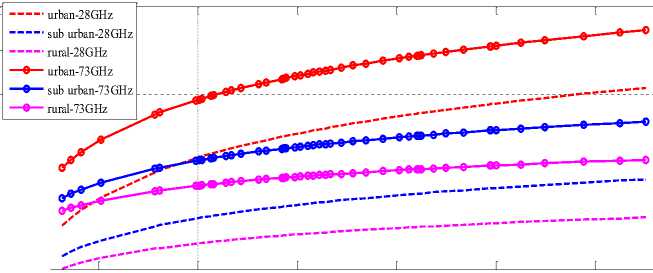
distance[m]
3.(a) LOS – Pathloss
NLOS path loss in different environments
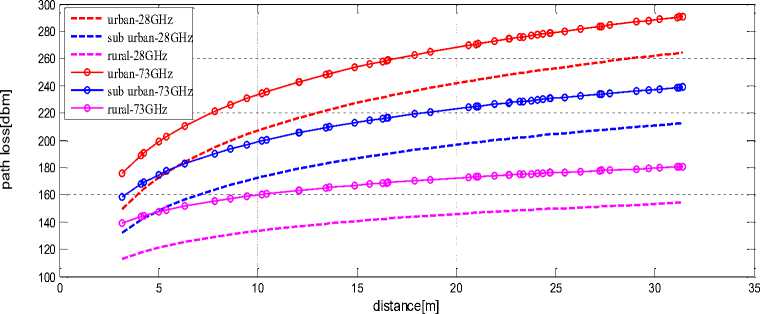
3.(b) NLOS – Pathloss
Fig.3. Distance Vs Pathloss characterstics in LOS and NLOS environment at 28GHz and 78GHz.
Fig.3 (a) and (b) gives the path loss performance as different user distances in LOS and NLOS paths. It is observed that the path loss is more pronounced in urban environment compared to sub urban and rural environments due to more propagation losses like rain attenuation and atmospheric absorption at 73GHz than
28GHz, it is also observed that at any distance path loss at 73GHz is more than that of 28GHz. Comparing Figure.3(a) and (b) , it is observed that due to more reflections and obstacles in NLOS environment, losses in NLOS is more compared to LOS environment.
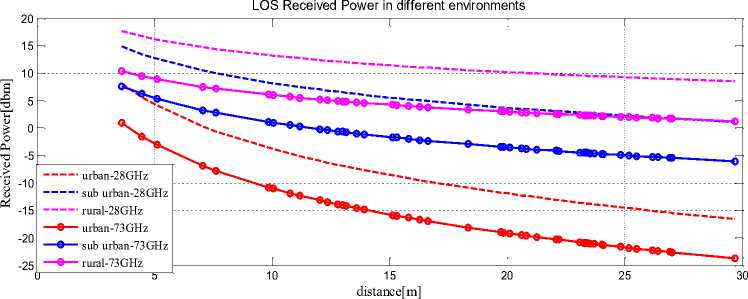
4.(a) LOS –Received Power
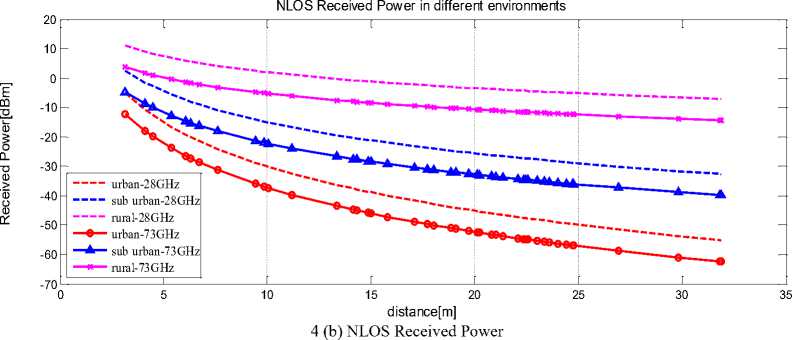
Fig.4. Distance Vs Received Power characterstics at 28GHz and 78GHz
From Fig. 4(a) and (b) it is observed that the received power in rural, sub urban and urban environments decreases with user distance. Due to more propagation losses like rain attenuation and atmospheric absorption at 73GHz than 28GHz, it is observed that at any distance received power at 28GHz is more than that of 73GHz. Comparing Fig.4.4 and Fig.4.5, it is observed that received power in NLOS environment, is less compared to LOS environment.
-
A. Coverage Analysis
Fig.5 and Fig.6 shows the coverage probability of a user at various SINR values in LOS and NLOS environment in case of urban, sub-urban and rural areas at different Gega Hz frequencies. It is observed that users in rural area attains more coverage compared to the users in suburban and urban areas. However percentage coverage probability in urban area can be increased by replacing omni directional antennas with directional antennas if perfect alignment is attained between transmitter and receiver with maximum received power [5]. NLOS region exhibit greater signal attenuation compared to LOS with respect to user distance from the base station.
Signal Propagation Analysis at 28GHz and 73GHz Millimeter Wave bands for Next Generation Networks
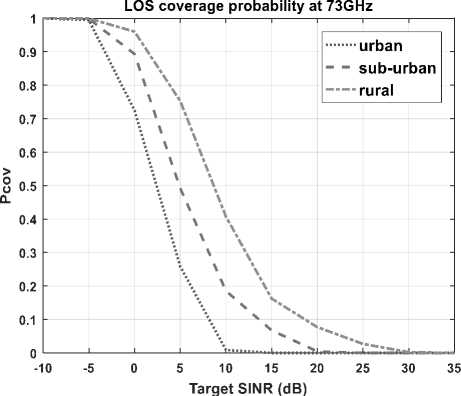
Fig.5. LOS Coverage Probability Vs Target SINR at 73 GHz and 28 GHz
LOS coverage probability at 28GHz
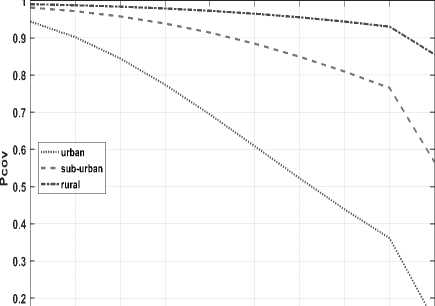
o.t
-10 -5 0 5 10 15 20 25 30 35
larger SINR(dB)
NLOS coverage probability at 73GHz
'"0"'urban sub-urban
8 0,5
0.2
-10 -5
k. 'A
>
^-^-^_^-^-*
10 15 20 25 30 35
Target SINR
NLOS coverage probability at 28GHz
'"0"' urban sub-urban
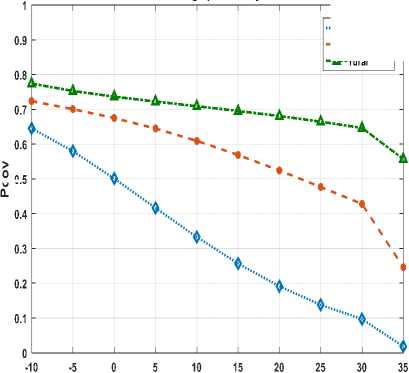
Q 0.5
Target SINR (dB)
Fig.6. Coverage Probability Vs Target SINR at 73 GHz and 28 GHz
-
B. Rate Analysis
7.(a) LOS environment
From Fig.7(a) and 7(b) it is observed that the data rates attained in rural, sub urban and urban environments decreases with user distance. Due to more propagation losses like rain attenuation and atmospheric absorption at 73GHz than 28GHz, it is observed that at any distance, data rate at 28GHz is more than that of 73GHz. Comparing Fig.7(a) and 7(b), it is observed that due to multiple reflections and obstacles in NLOS environment, data rate in NLOS environment is less compared to LOS environment.
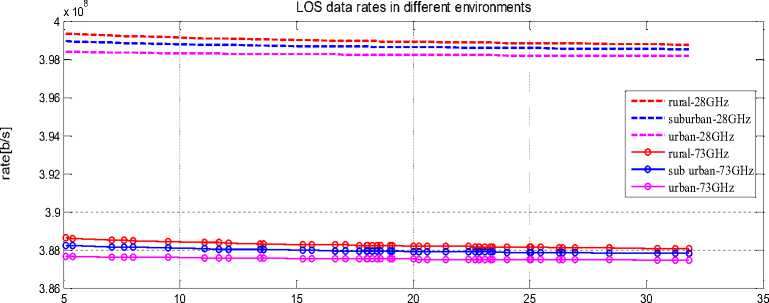
distance[m]
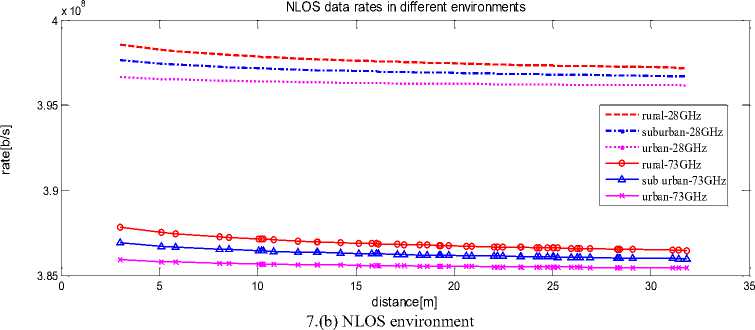
Fig.7. Distance Vs Rate characterstics at 28GHz and 73GHz
-
V. Conclusions
The current and next generation wireless networks demand large amount of bandwidth and high spectral efficiency that can be made possible by using available spectrum in mmWave bands. In the present work, signal propagation performance parameters including Path loss, Received power, SINR coverage probability and Data rates in mm-Wave bands of 28GHz and 73GHz are analyzed in a microcell. Results are plotted for LOS and NLOS propagation behavior for urban, Suburban and rural environments at different frequency bands. Millimeter wave communication at 28GHz gives pronounced results in all the three environments with additional path loss due to atmospheric absorptions. Since rain attenuation and atmospheric absorption is more at 73GHz, 28GHz band is preferred for 5G mobile communications over 73GHz in mm-Wave band. However the attenuation at 73 GHz may be overcome by employing an adaptive antenna array which poses additional cost and complexity. It can be concluded that data rate capacity and coverage in mmWave band at 28GHz could meet the requirements of the congestion problem in future wireless broadband communications.
Future scope of the work includes implementation of heterogeneous network environment(HetNet) with macro and femto cell combination with macro operated in sub 6GHz frequency and femto cells operating in the range of mmWave bands. Performance improvement for the specified evaluated parameters in this work can be attained with HetNet environment operating in mmWave bands predominantly in the aspect of speed, coverage and spectral efficiency.
Список литературы Signal propagation analysis at 28GHz and 73GHz millimeter wave bands for next generation networks
- Afif Osseiran, Federico Boccardi, Volker Braun, Katsutoshi Kusume, Patrick Marsch, Michal Maternia, Olav Queseth, Malte Schellmann, Hans Schotten, Hidekazu Taoka, Hugo Tullberg, Mikko A. Uusitalo, Bogdan Timus, Mikael Fallgren, “Scenarios for the 5G Mobile and Wireless Communications: the Vision of the METIS Project”, IEEE Communication Magazine, Volume: 52, Issue: 5, pp. 26-35, 2014.
- C X Wang, F Haider, X Gao, X Hu You, Y Yang, D Yuan, H Aggoune, H Haas, S Fletcher, “Cellular architecture and key technologies for 5G wireless communication networks,” IEEE Communication Magagine., vol. 52, no. 2, pp. 122–130, 2014.
- Federal Communication Commission, ‘Spectrum Frontiers R&O and FNPRM: FCC16-89, Jul. 2016, [online] Available:https://apps.fcc.gov/edocs_public/attachmatch/FCC-16-89A1.pdf, 2016.
- G. R. Maccartney, Jr., T. S. Rappaport, S. Sun, and S. Deng, “Indoor office wideband millimeter-wave propagation measurements and channel models at 28 and 73 GHz for ultra-dense 5G wireless networks,”IEEE Access, vol. 3, pp. 2388–2424, 2015.
- George R. MacCartney, Theodore S. Rappaport, Amitava Ghosh, “Base Station Diversity Propagation Measurements at 73 GHz Millimeter-Wave for 5G Coordinated Multipoint (CoMP) Analysis”, Globecom Workshops (GC Wkshps), IEEE, 2017.
- ITU-R, ‘Attenuation by atmospheric Gases’ Tech. Rep. P676-11, 2016.
- Li, Q.C., Niu, H., Papathanassiou, A.T., Wu, “5G network capacity: Key elements and technologies”, IEEE Vehicular Technology Magazine, Volume 9, Issue 1, Article number 6730679, pp. 71-78, 2014.
- Mukesh Chandra Kestwal, Sumit Joshi, and Lalit Singh Garia, “Prediction of Rain Attenuation and Impact of Rain in Wave Propagation at Microwave Frequency for Tropical Region (Uttarakhand, India)”, International Journal of Microwave Science and Technology, Volume, Article ID 958498, 6 pages, Technol. Conf. (VTC-Spring), pp. 1-6, 2014.
- Mathew K. Samimi, Theodore S. Rappaport, and George R. MacCartney, Jr “Probabilistic Omnidirectional Path Loss Models for Millimeter-Wave Outdoor Communications”, IEEE Wireless Communications Letters, Volume. 4, no.. 4. pp. 357-360, 2015.
- METIS2020, “METIS Channel Model,” Tech. Rep. METIS2020, Deliverable D1.4 v3, [Online]. Available: https://www.metis2020.com/wpcontent/ uploads/METIS, 2015.
- Muhammad Shahmeer Omar , Muhammad Ali Anjum, “Performance analysis of hybrid 5G cellular networks exploiting mmWave capabilities in suburban areas” , IEEE International Conference on Communications (ICC), 2016.
- S. Akoum, E. O. Ayach, R. W. Heath "Coverage and capacity in mmWave cellular systems", Proc. 46th ASILOMAR, pp. 688-692, 2012.
- S. Sun, Theodore S. Rappaport, Sundeep Rangan, Timothy A. Thomas, Amitava Ghosh ,Istv, nZ.Kovcs, Ignacio Rodriguez, OzgeKoymen, Andrzej Partyka, and Jan J̈arvel ainen "Propagation path loss models for 5G urban micro-and macro-cellular scenarios", Proc. IEEE 83rd Veh, 2016.
- Theodore S. Rappaport, Shu Sun, Nimma Mayzus, HangZhao, Yaniv Azar, Kevin Wang, george n. Wong1, Jocelyn K. Schulz, Mathew Samimi and Felix gutierrez “Millimeter Wave Mobile Communications for 5G Cellular: It Will Work!”, IEEE Access, Vol. 1, pp. 335-349, 2013.
- T. S. Rappaport, R. W. Heath, Jr., R. C. Daniels, and J. N. Murdock, “MillimeterWaveWireless Communications”. Englewood Cliffs, NJ, USA:Prentice-Hall, 2015.
- Theodore S. Rappaport, Yunchou Xing, George R. MacCartney, Andreas F. Molisch, Evangelos Mellios, Jianhua Zhang, “Overview of Millimeter Wave Communications for Fifth-Generation (5G) Wireless Networks—With a Focus on Propagation Models”, IEEE Transactions on Antennas and Propagation, vol. 65, pp. 6213-6230, 2017.
- Xianghao Yu, Jun Zhang, Jun Zhang “Coverage analysis for dense millimeter wave cellular networks: The impact of array size” IEEE Wireless Communications and Networking Conference (WCNC), - Track 2 - MAC and Cross Layer Design, pp. 17-22, 2016.
- Z. Pi, F. Khan, "An introduction to Millimeter-wave mobile broadband systems", IEEE Communication. Magazine, vol. 49, no. 6, pp. 101107, 2011.
- 38.901V13GPP, “Technical specification group radio access network; study on channel model for frequencies from 0.5 to 100GHz(Release14),”3rdGenerationPartnershipProject(3GPP),TR.0.1,Mar.2017.[Online].Available:http://www.3gpp.org/DynaReport/38901.html.

